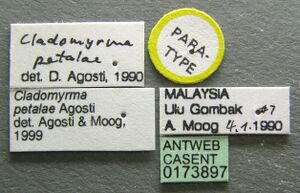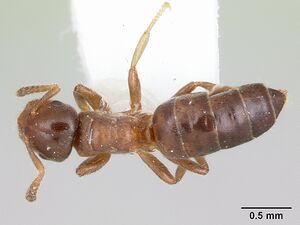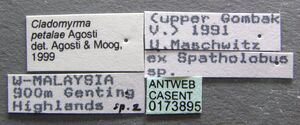Cladomyrma petalae
| Cladomyrma petalae | |
|---|---|

| |
| Scientific classification | |
| Kingdom: | Animalia |
| Phylum: | Arthropoda |
| Class: | Insecta |
| Order: | Hymenoptera |
| Family: | Formicidae |
| Subfamily: | Formicinae |
| Tribe: | Plagiolepidini |
| Genus: | Cladomyrma |
| Species: | C. petalae |
| Binomial name | |
| Cladomyrma petalae Agosti, 1991 | |
| Synonyms | |
| |
Cladomyrma petalae, like all Cladomyrma species, are arboreal ants. This species nests in excavated vines and tree branches. The tropical forests where their hosts occur experience frequent and strong rains. The risk of rain and rain-runoff getting into C. petalae nests is mitigated in part by their laterally oriented nest-entrances. If water does get into a nest, it is removed using a water-bailing behavior. The workers ingest the liquid and regurgitate it to the outside until no standing water remains. (Moog et al., 1997)
Identification
Agosti et al. (1999) placed Cladomyrma species into two groups based on the shape of the queen's petiole, raised (an erect node or scale) or depressed (dorsally truncate and low). Cladomyrma petalae belongs to the depressed petiole group.
This species is distinguished from all other species in the queen caste by the shining dorsal part of the katepisternum, the lateral part of the propodeum below the spiracle being devoid of any pubescence, the small, narrow metapleural gland orifice, and the low, dorsally truncated petiole. There is variation in coloration and pilosity, including the pubescence.
Keys including this Species
Distribution
Distribution based on Regional Taxon Lists
Indo-Australian Region: Borneo, Indonesia, Malaysia (type locality).
Distribution based on AntMaps
Distribution based on AntWeb specimens
Check data from AntWeb
Countries Occupied
| Number of countries occupied by this species based on AntWiki Regional Taxon Lists. In general, fewer countries occupied indicates a narrower range, while more countries indicates a more widespread species. |

|
Estimated Abundance
| Relative abundance based on number of AntMaps records per species (this species within the purple bar). Fewer records (to the left) indicates a less abundant/encountered species while more records (to the right) indicates more abundant/encountered species. |

|
Biology
This species has been found in a set of six syntopic host plants; the understory trees Saraca thaipingensis (Caesalpiniaceae), Drypetes longifolia (Euphorbiaceae), and Ryparosa fasciculata (Flacourtiaceae); and the woody climbers Strychnos vanprukii (Loganiaceae), Luvunga sp. (Rutaceae), and Spatholobus bracteolatus (Papilionaceae) (Maschwitz et al., 1991, Moog and Maschwitz, 1994, Moog et al., in press). Despite this highly diverse host range, both field studies and extensive examination of herbarium specimens have shown that congeneric host plant species are not colonized by C. petalae (Moog et al., in prep.). Preliminary results of ‘‘host acceptance’’ experiments with colony-founding queens collected from Saraca and Spatholobus and placed on one of the other syntopic host plants indicate that foundress queens sometimes accept an alternative host species (unpublished results). However, they do not accept any other plant species with suitable internodes (controls). The mechanisms underlying this surprising queen response to particular, taxonomically diverse host plants is not yet understood and needs further study. In Saraca (and other hosts), worker activity on the plant surface is concentrated on young developing foliage and the ants reduce herbivore damage to young leaves significantly (Moog and Maschwitz, 1994; unpubl. results). This species also precludes oviposition by female lycaenid butterflies. In addition, lycaenid larvae, even myrmecophilic ones, placed on leaf flushes and confronted with patrolling workers never survive (Seufert and Fiedler, 1996)
Castes
Worker
Images from AntWeb
   
| |
| Paratype of Cladomyrma petalae. Worker. Specimen code casent0173897. Photographer April Nobile, uploaded by California Academy of Sciences. | Owned by CAS, San Francisco, CA, USA. |
Queen
Images from AntWeb
   
| |
| Worker. Specimen code casent0173895. Photographer April Nobile, uploaded by California Academy of Sciences. | Owned by CAS, San Francisco, CA, USA. |
    
| |
| Queen (alate/dealate). Specimen code casent0173896. Photographer April Nobile, uploaded by California Academy of Sciences. | Owned by CAS, San Francisco, CA, USA. |
Nomenclature
The following information is derived from Barry Bolton's Online Catalogue of the Ants of the World.
- petalae. Cladomyrma petalae Agosti, 1991: 308, figs. 13, 16, 20, 25, 26 (s.w.q.m.) WEST MALAYSIA.
- Type-material: holotype queen, 24 paratype workers, 2 paratype queens, 6 paratype males.
- Type-locality: holotype Malaysia: Selangor, Ulu Gombak, 12.i.1990 (J. Moog); paratypes with same data.
- Type-depositories: BMNH (holotype); BMNH, DAPC, FRKL, MCZC, MHNG (paratypes).
- Status as species: Bolton, 1995b: 146; Agosti, et al. 1999: 13 (redescription); Pfeiffer, et al. 2011: 39; Khachonpisitsak, et al. 2020: 47.
- Senior synonym of mossyna: Agosti, et al. 1999: 13.
- Distribution: Malaysia (Peninsula), Thailand.
- mossyna. Cladomyrma mossyna Agosti, 1991: 307, figs. 14, 17, 22 (s.w.q.) WEST MALAYSIA.
- Type-material: holotype queen, 5 paratype major workers, 5 paratype minor workers.
- Type-locality: holotype Malaysia: Selangor, Ulu Gombak, 1.xi.1988, no. 873 (U. Maschwitz); paratypes with same data.
- Type-depositories: BMNH (holotype); BMNH, DAPC, FRKL, MCZC, MHNG (paratypes).
- Status as species: Bolton, 1995b: 146.
- Junior synonym of petalae: Agosti, et al. 1999: 13.
Unless otherwise noted the text for the remainder of this section is reported from the publication that includes the original description.
Description
Agosti et al. (1999):
Worker
Major worker. AL 0.86–1.42, HL 0.86–1.24, HW 0.78–1.16, EL 0.16–0.23, SL 0.38–0.60, CI 84–95, EI 18–21, SI 47–53 (n = 18).
Clypeus with longitudinal sculpture; gastral pubescence dense and regular; erect pilosity all over alitrunk, without a distinct increase on the propodeum; short, erect hairs on gaster, mainly along posterior margin of tergites, but with scattered hairs in between; erect hairs white. Minor worker.
AL 0.60–0.98, HL 0.63–0.86, HW 0.53–0.82, EL 0.12–0.18, SL 0.31–0.44, CI 84–95, EI 19–26, SI 48–65 (n = 18).
Clypeus without longitudinal sculpture, smooth; few long erect hairs on dorsal face of propodeum; very dense decumbent pubescence on gaster; body color dark brown, with propodeum and petiole slightly brighter; small body size.
Queen
AL 2.26–2.56, HL 1.42–1.56, HW 1.15–1.27, EL 0.46–0.54, SL 0.66–0.72, CI 81–84, EI 38–43, SI 53–59 (n = 18). Holotype: Queen AL 2.56, HL 1.51, HW 1.24, SL 0.72, EL 0.52, CI 82, EI 42, SI 58.
Dorsal part of an- and katepisternum without erect hairs; very flat, dorsally truncate petiole; very few erect hairs on base of first gastral tergite; coloration variable, even within one nest, from uniform yellowish with darker posterior margins of gastral tergites to completely dark brown; in most cases at least genae lighter colored.
Type Material
Holotype queen, W-MALAYSIA, Selangor, Ulu Gombak, 1/12/1990, Joachim Moog, ex: Saraca thaipingensis, The Natural History Museum. Holotype queen, W-MALAYSIA, Selangor, Ulu Gombak, 11/1/1988, Ulrich Maschwitz, #873, ex: Saraca thaipingensis, BMNH.
References
- Agosti, D. 1991. Revision of the oriental ant genus Cladomyrma, with an outline of the higher classification of the Formicinae (Hymenoptera: Formicidae). Systematic Entomology. 16:293-310.
- Agosti, D., J. Moog, U. Maschwitz. 1999. Revision of the Oriental plant-ant genus Cladomyrma. American Museum Novitates. 3283:1-24.
- Cantone S. 2018. Winged Ants, The queen. Dichotomous key to genera of winged female ants in the World. The Wings of Ants: morphological and systematic relationships (self-published).
- Khachonpisitsak, S., Yamane, S., Sriwichai, P., Jaitrong, W. 2020. An updated checklist of the ants of Thailand (Hymenoptera, Formicidae). ZooKeys 998, 1–182 (doi:10.3897/zookeys.998.54902).
References based on Global Ant Biodiversity Informatics
- Pfeiffer M.; Mezger, D.; Hosoishi, S.; Bakhtiar, E. Y.; Kohout, R. J. 2011. The Formicidae of Borneo (Insecta: Hymenoptera): a preliminary species list. Asian Myrmecology 4:9-58

